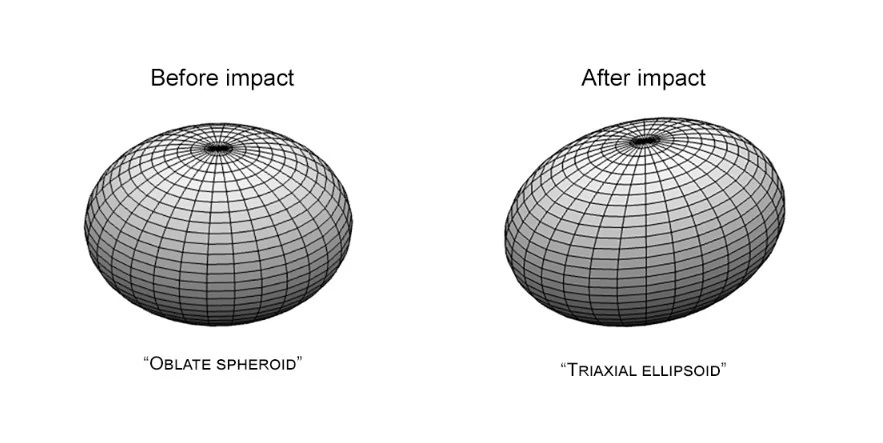DART impact altered Dimorphos’ orbit and shape, proving asteroid deflection technique viable

On September 26, 2022, NASA’s Double Asteroid Redirection Test (DART) mission made history by intentionally colliding with the asteroid Dimorphos, significantly altering both its orbital period and physical shape. This is the first time humanity has purposefully altered the motion of a celestial object, as well as the first full-scale demonstration of asteroid deflection technology.
- This demonstration confirmed the viability of a kinetic impactor as a method for asteroid deflection.
- Recent findings detail transformative effects on Dimorphos, previously a symmetrical “oblate spheroid,” now reshaped into a “triaxial ellipsoid” and its orbit around the larger asteroid Didymos notably shortened.
On September 26, 2022, DART successfully impacted Dimorphos, an asteroid measuring approximately 170 m (558 feet) in width, which orbits the larger near-Earth asteroid Didymos. Now, a new study published in the Planetary Science Journal has confirmed the impact has changed not only the motion of the asteroid, but also its shape.
The mission marked humanity’s first deliberate attempt to alter the motion of a celestial body, marking a significant advance in our capability to protect Earth from potential asteroid impacts.
Before the impact, Dimorphos was characterized by its oblate spheroid shape, resembling a squashed ball, with a clearly defined, circular orbit around Didymos at a distance of about 1 189 m (3 900 feet). The collision has resulted in notable changes to both its orbit and shape.
The findings were presented in a new study, leveraging data from DART’s spacecraft images, the Goldstone Solar System Radar, and ground telescope observations of light curves.
The study shows that the orbital path of Dimorphos became more eccentric and that the asteroid also exhibits a rocking motion as it orbits Didymos. This detailed analysis was made possible by the precise timing of light-curve dips observed during mutual events between Didymos and Dimorphos.
According to Shantanu Naidu, a navigation engineer at NASA’s Jet Propulsion Laboratory and lead of the study, the orbital period of Dimorphos has been reduced by 33 minutes and 15 seconds, and the asteroid now presents a triaxial ellipsoid shape, significantly diverging from its prior symmetry.
Following the impact, Dimorphos’s orbital period experienced an immediate reduction, indicating a closer average distance to Didymos.
The final measurements suggest Dimorphos now orbits Didymos at about 1 152 m (3 779 feet), closer by approximately 37 m (121.4 feet) than before the collision.
This finding is corroborated by the debris analysis post-impact, suggesting Dimorphos’s composition as a “rubble pile,” similar to that of asteroid Bennu.
The upcoming European Space Agency’s Hera mission will conduct detailed surveys of both Dimorphos and Didymos, with a particular focus on the crater left by DART’s collision and a precise measurement of Dimorphos’ mass.
References:
1 NASA Study: Asteroid’s Orbit, Shape Changed After DART Impact – NASA – March 19, 2024
2 Orbital and Physical Characterization of Asteroid Dimorphos Following the DART Impact – Naidu et al. – 2024 Planet. Sci. J. 5 74 – DOI 10.3847/PSJ/ad26e7
Featured image: Illustration showing the approximate shape change that the asteroid Dimorphos experienced after DART hit it. Before impact, left, the asteroid was shaped like a squashed ball; after impact it took on a more elongated shape, like a watermelon. Credit: NASA/JPL-Caltech


Commenting rules and guidelines
We value the thoughts and opinions of our readers and welcome healthy discussions on our website. In order to maintain a respectful and positive community, we ask that all commenters follow these rules.